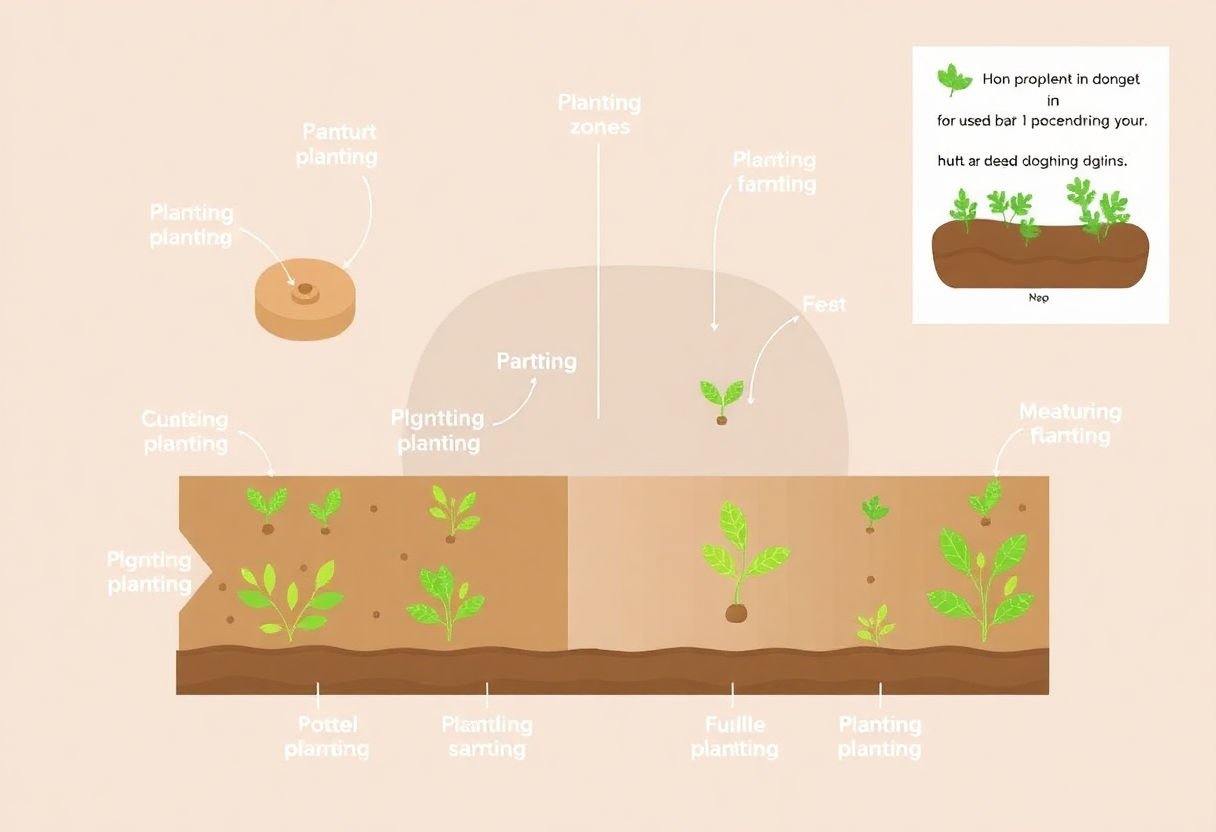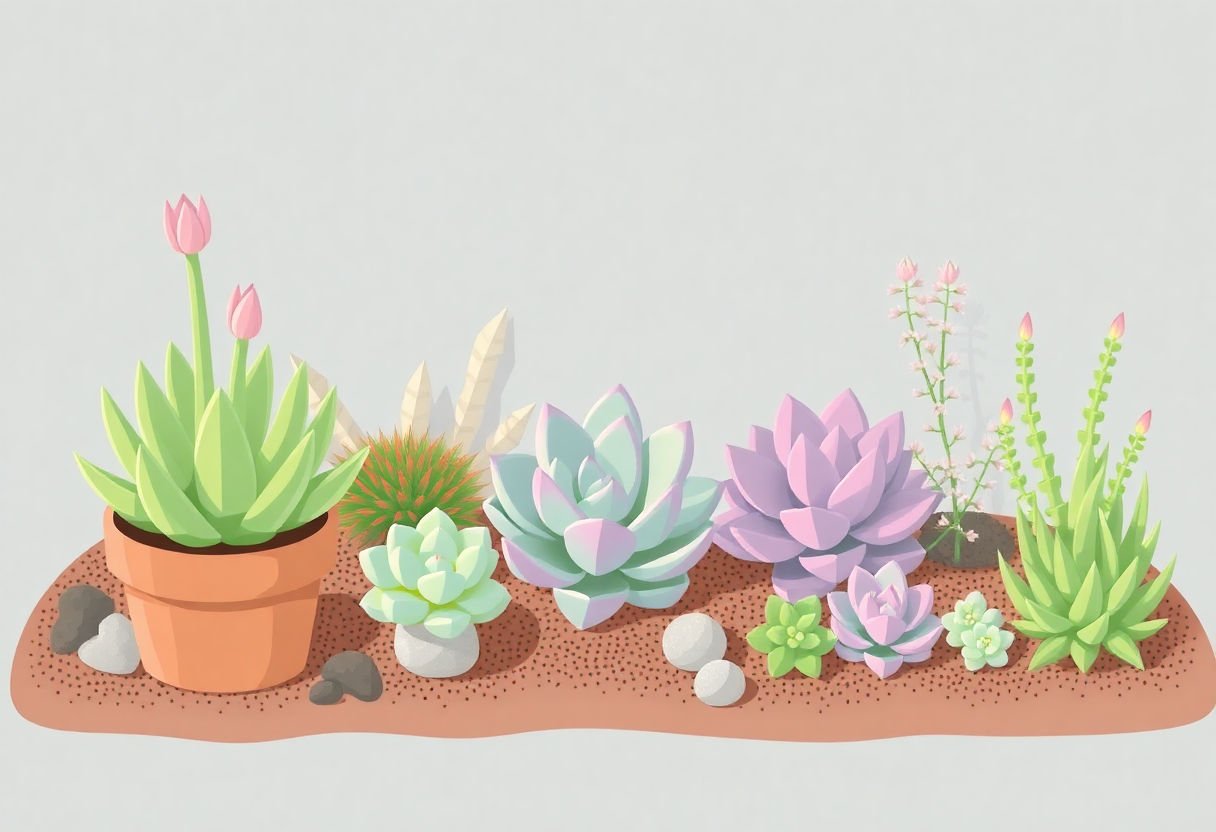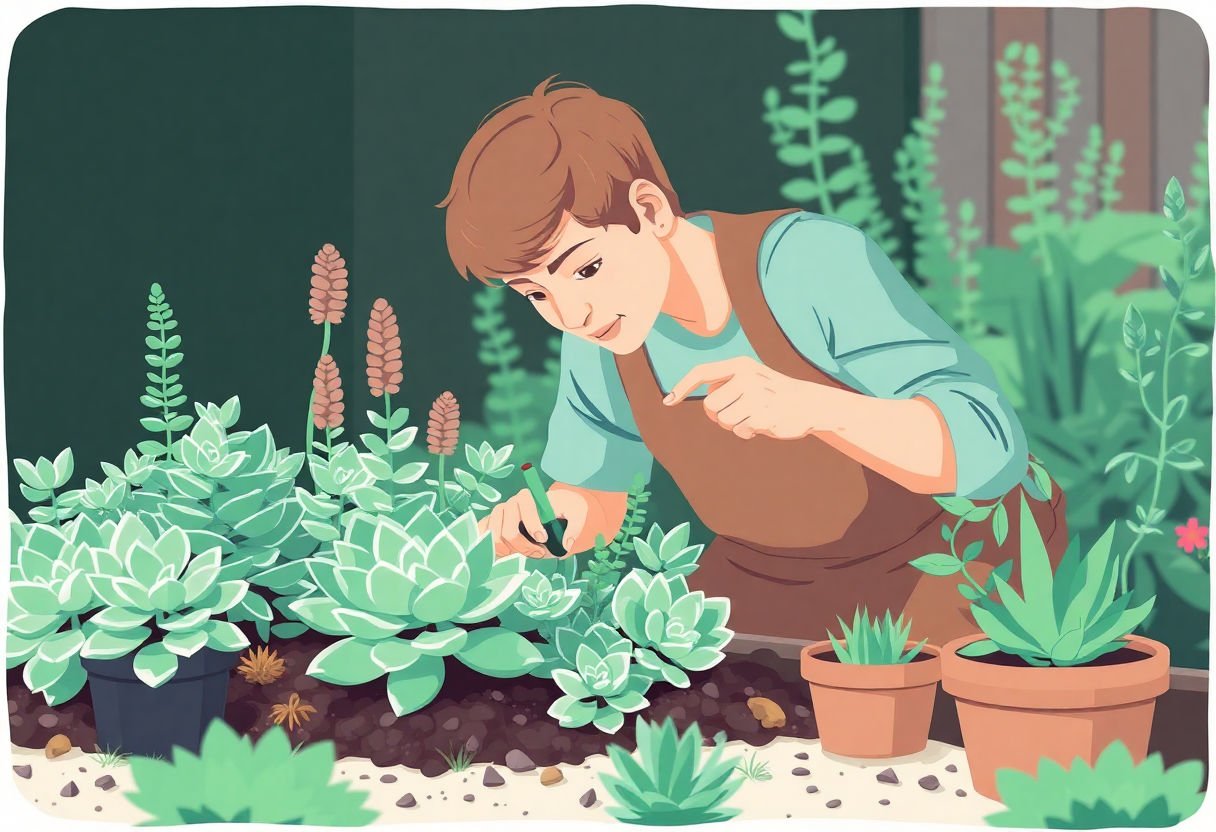Understanding the intricacies of planting zones is essential for enhancing the growth of succulents, ensuring these resilient plants thrive in diverse environments. By exploring how planting zones influence succulent growth, gardeners can make informed decisions on the best zones for planting, ultimately promoting the health and vitality of their plants. This article delves into the nuances of zone classifications, the benefits of selecting appropriate zones, and provides actionable advice for growing succulents successfully. By embracing this knowledge, you set the foundation for flourishing succulent gardens tailored to specific climatic conditions, whether inside or outside their ideal zones.
Key Takeaways
- Understanding planting zones is crucial for optimizing succulent growth, as they determine the environmental conditions best suited for each plant variety.
- Zones are influenced by several factors including temperature, frost dates, and climate, which together dictate the survivability and health of succulents.
- Growing succulents within their appropriate zones enhances their vitality, ensuring improved health and fewer maintenance challenges.
- For successful gardening, it is essential to select succulent varieties that are compatible with the local planting zone to maximize growth potential.
- When cultivating succulents outside their ideal zones, adjustments in care and environment can mitigate potential stress and support growth.
Understanding Planting Zones

Planting zones, also known as hardiness zones, are geographic areas that categorize the characteristics of plant survival and growth based on climatic conditions. In the United States, the USDA Plant Hardiness Zone Map is widely utilized to classify regions from Zone 1 (the coldest) to Zone 13 (the warmest). This classification primarily reflects the average annual minimum winter temperature, providing a guideline for the suitability of plant species, including succulents, in particular areas.
Understanding planting zones is pivotal for gardeners who want to optimize succulent growth. These zones inform gardeners about the climatic conditions that plants, especially succulents, can withstand during unfortunate weather spells, particularly cold snaps. The zones enable the prediction of which succulents will thrive naturally and which might require additional care to survive outside their native environment.
The significance of planting zones extends beyond mere temperature indications; they offer insights into the length of growing seasons and potential frost dates. By aligning the needs of succulents with appropriate zones, gardeners can significantly enhance the health and resilience of their plants. For instance, succulents native to warm climates may struggle and require protective measures in cooler zones, highlighting the importance of zone consideration.
In summary, comprehending and utilizing planting zones can make the difference between bountiful and struggling succulent gardens. This understanding ensures that succulent enthusiasts can make informed decisions, paving the way for thriving and visually appealing displays of succulent varieties regardless of regional variances in climate.
Factors Influencing Zone Classifications
Understanding the factors influencing zone classifications is essential for successful succulent cultivation. These classifications are primarily based on temperature ranges, which crucially affect plant survival and growth. The USDA Hardiness Zones, for example, are determined by the average annual minimum winter temperature. This information allows gardeners to select plants likely to thrive in their region, particularly for cold-sensitive succulents.
Frost dates also play a significant role. These dates mark the period when frost can be expected, helping cultivators anticipate and mitigate potential damage to their plants. Succulents are generally more vulnerable to frost; therefore, knowing these dates aids in planning protective measures, such as bringing plants indoors or utilizing frost cloths.
Another key factor is the overall climate conditions of an area, which include not just temperature, but also humidity, rainfall, and sunlight. Succulents, which usually prefer arid conditions, may struggle in regions with high humidity or excessive rainfall. Understanding these factors helps in making necessary adjustments, such as using well-draining soil to prevent root rot.
In some regions, microclimates can add another layer of complexity. These localized climate variations can result from geographical features like hills, bodies of water, or urban environments. Recognizing and adapting to the unique conditions within these microclimates can significantly improve the growth prospects for succulents.
By taking into account these various elements—temperature, frost dates, climate conditions, and microclimates—gardeners can make informed decisions on how to cultivate succulents that are robust and vibrant, even in challenging environments.
Benefits of Growing Succulents in Appropriate Zones

Growing succulents in the appropriate zones offers several significant benefits that enhance their health and longevity. By selecting the correct zones, you ensure that your succulents can thrive in optimal climate conditions, which directly supports their growth patterns and overall vitality.
One primary advantage is improved plant resilience. Succulents adapted to specific zones are better equipped to handle the local environmental challenges, such as temperature fluctuations and moisture levels. This resilience reduces the risk of stress and damage, leading to fewer instances of disease and pest infestations.
Another benefit is the enhancement of natural beauty. When succulents are grown in climates that mimic their natural habitats, they tend to exhibit more vibrant colors and robust foliage. This aesthetic advantage not only improves the visual appeal of your garden but also indicates the plant’s health.
Moreover, choosing suitable zones can lead to lower maintenance requirements. Succulents are known for their drought resistance, and when they are planted in zones that align with their hydration needs, there is less need for supplemental watering. This characteristic not only conserves water but also simplifies the care routine for gardeners.
Finally, cultivating succulents in appropriate zones can lead to greater yield and propagation success. Succulents that are comfortable in their environment are more likely to produce offsets or “pups,” enabling gardeners to expand their collections with less effort.
In summary, understanding and selecting the right zones for succulent growth fosters healthier plants, maximizes natural beauty, and reduces maintenance, making it crucial for succulent enthusiasts in the United States.
Identifying Your Local Planting Zone

To successfully cultivate succulents, identifying your local planting zone is a fundamental step that cannot be overlooked. The U.S. Department of Agriculture (USDA) has developed a Hardiness Zone Map, which classifies the country into 11 zones based on the average annual minimum winter temperature. This map is an essential tool for understanding the climatic conditions of your area, which serve as a blueprint for determining the most suitable plants.
Accessing Zone Information:
- The USDA Plant Hardiness Zone Map is widely available online and in gardening centers. By entering your ZIP code, you can quickly identify your zone.
- Local extension services often provide detailed zone maps and additional insights specific to your locale.
Utilizing Zone Maps Effectively:
- Once you know your zone, tailor your succulent choices to those that thrive within your environment’s temperature range to ensure optimal growth.
- Keep in mind that microclimates might exist in your garden, offering slightly warmer or cooler conditions than the standard zone classification would suggest.
Practical Application:
- For example, succulents such as the Hens and Chicks (Sempervivum) are well-suited for cooler zones, while the Aloe Vera thrives in warmer, more temperate zones.
- Use the zone information to plan your planting schedule, specifically timing the planting and potential relocation indoors during adverse weather conditions.
By understanding and applying the knowledge of planting zones, succulent gardeners can create environments that are conducive to the health and prosperity of their plants, thereby enhancing their beauty and longevity.
Choosing the Right Succulents for Your Zone
Choosing the right succulents for your zone is crucial for ensuring their optimal growth and survival. Each planting zone has specific environmental conditions that can directly impact the health of your succulents. Therefore, understanding which varieties will flourish in your particular zone is vital.
Different succulents have varying degrees of tolerance to the elements. For instance, Hardy succulents are suitable for zones 3 through 9 as they can withstand colder temperatures, making them perfect for regions experiencing harsh winters. Varieties like Sedum and Sempervivum are known for their resilience and ability to thrive in these cooler climates.
On the other hand, tender succulents such as Echeveria and Crassula are better suited for warmer zones, typically ranging from zone 9 upwards. These succulents fare well in the milder, more temperate climates found in these areas, where they are not exposed to frost or extreme cold.
To identify the best succulents for your zone, consider:
- Temperature: Research the minimum temperatures each succulent variety can tolerate.
- Moisture levels: Understand the watering needs of the succulents, ensuring they match your local average rainfall.
- Sun exposure: Determine how much sunlight the succulents will receive and opt for varieties that match these light conditions.
Implementing these considerations not only enhances the growth potential of your succulents but also reduces maintenance efforts, as well-suited succulents for your zone naturally thrive with less intervention. This approach ensures your succulent garden is both beautiful and sustainable, providing a lush and vibrant display throughout the year.
Adjustments for Out-of-Zone Growing

While planting succulents within their designated zones is ideal, growing them outside of these parameters is not impossible. However, it requires making conscious adjustments to nurture their growth effectively. Succulents, being resilient, can often adapt if care methods are properly modified.
Microclimates: Take advantage of microclimates in your garden. These are small areas where the climate condition differs from the surrounding area. For example, placing succulents near walls can provide them with additional warmth and protection from wind chill, simulating a warmer environment.
Container Growing: Consider growing succulents in pots or containers, allowing for easy movement. This approach enables gardeners to relocate succulents indoors during colder months or to positions where they can receive optimal sunlight and temperature control.
Soil Modifications: Utilizing well-draining soil is crucial for succulents, especially in out-of-zone areas. Enhance soil drainage by mixing sand or gravel into your potting mix, which helps to prevent root rot in damp climates.
- Potting Mix: Ensure it contains at least 50% inorganic matter like perlite or pumice.
- Elevated Beds: Implement raised beds for better drainage and temperature control.
Temperature Adjustments: Employ frost cloths or garden blankets to shield succulents from extreme cold or hot temperatures. Additionally, providing artificial heat sources like heat lamps can protect them during harsh winters.
“Clever adaptations acclimate your succulents to thrive beyond their natural zones,” as experienced growers often say. These strategies not only protect succulents from unfavorable conditions but also enhance their resilience and longevity, contributing to a thriving garden regardless of geographical limitations.
Common Mistakes in Zone Selection
Mistakes in zone selection can significantly impact the growth and health of succulents. One common error is misidentifying the local zone. Gardeners often rely on outdated or incorrect zone maps, leading to poor succulent performance. It’s crucial to verify zone information with reputable sources like the USDA’s updated maps.
Another error involves planting outside of recommended zones without considering necessary adjustments. While some succulents can survive in non-ideal conditions, they may require specific care, such as additional frost protection or altered watering schedules. Ignoring these needs often results in stressed and unhealthy plants.
Gardeners frequently overlook microclimates within their broader planting zones. Factors such as urban environments, elevation, and proximity to bodies of water can create significant variations in climate conditions. By failing to account for these microclimates, succulents may experience unexpected difficulties.
Assuming all succulents are zone hardy is another prevalent mistake. Not all succulents are created equal; some require warmer temperatures, while others thrive in cooler climates. Researching the specific needs of each succulent species is vital to ensure compatibility with local conditions.
Lastly, many growers neglect to monitor ongoing climatic changes. As global weather patterns shift, so too can local planting zones. Being proactive and adaptive in response to these changes can help maintain the long-term health of succulent collections.
Avoiding these common mistakes by carefully assessing zone information and adjusting care practices accordingly can significantly enhance succulent growth and sustainability.
Conclusion
Planting zones are a fundamental aspect of successful succulent gardening, providing a framework for selecting the best possible environments for growth. By aligning succulent varieties with the most suitable zones, gardeners can ensure robust health and vitality, capitalizing on natural climate conditions. As awareness of proper zone selection grows, this knowledge can be carried into future gardening endeavors, promising more sustainable and vibrant succulent displays. Embrace this understanding to avoid common pitfalls and maximize the beauty and health of your succulent collection.
Frequently Asked Questions
What are planting zones, and why are they important for succulents?
Planting zones, specifically the USDA Plant Hardiness Zones, are regions defined by their climatic conditions, particularly the minimum temperatures. These zones are crucial for succulents as they guide gardeners in choosing plants that will thrive in the local climate, reducing the risk of freeze damage.
How can I determine my local planting zone for succulents?
You can identify your local planting zone by referring to the USDA Plant Hardiness Zone Map, which is available online. By entering your zip code, you can find the zone that corresponds to your area, aiding you in selecting suitable succulent varieties.
Can succulents grow outside their recommended zones?
While succulents can sometimes survive outside their ideal zones, they may require special care, such as indoor overwintering or additional protection from extreme temperatures. Growing them outside of their recommended zones can affect their growth and lifespan.
What are common factors affecting zone classifications?
Zone classifications are primarily influenced by temperature ranges, particularly the average annual low temperatures. Other factors include the length of growing seasons and the local frost dates, which can significantly impact plant survivability.
Are all succulents suitable for all zones?
Not all succulents are suitable for every zone, as different species have varying temperature and climate preferences. It’s essential to choose succulents adapted to your specific zone for optimal growth and to minimize maintenance challenges.
